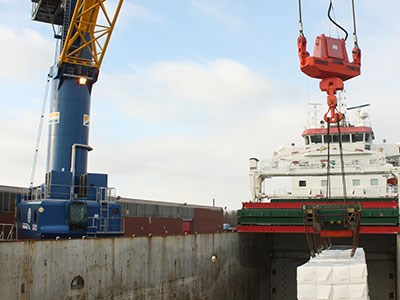Optimism abounds at the port of Thunder Bay heading into the 2013-14 navigation season.
Marine operators on the Great Lakes are forecasting a big swell in traffic along the length of the St. Lawrence Seaway and those waves of good vibes are stretching all to the Lakehead as the new shipping season got underway in late March.
Last year, the western Lake Superior port handled more than 7.8 million tonnes of cargo during the shipping season and recorded 408 ships in the harbour loading and unloading grain, potash, coal and general cargoes.
It's the first time since 2008 that vessel calls topped 400. Seventy-two were ocean freighters. Port authority CEO Tim Heney said most of that traffic came at year's end with the fall grain rush – prior to the winter freeze-up – that was higher than usual.
Wheat totals were up 10 per cent in 2012 with overall grain tonnage registering as the port's second highest since 2001.
“Most of our gains were made in the last quarter after the Wheat Board change. We're hoping that trend continues.”
The Canadian Wheat Board once held a stranglehold on Western Canadian grain movements. That monopoly was eliminated last August and now farmers can move their crop when they see fit and when the price is right.
“We were on the optimistic side but nobody really knew (the impact). There's always been a Wheat Board as long as there's been a Seaway. As it turns it looks quite positive,” said Heney.
Even though many of the major grain companies like Richardson, Cargill and Viterra have elevators in the harbour, Heney said the Wheat Board wasn't keen on booking ocean vessels out of Thunder Bay.
“That was always a debate we had with them, but now that the monopoly is ending, we're seeing more of them. I think that will continue.”
The bulk of the grain that moves through Thunder Bay elevators is bound for Europe, North Africa and Latin America.
Heney said it's difficult to make a bold forecast whether grain shipment patterns will increasingly flow east.
Shippers use different routes to get to Europe, including West Coast and U.S. Gulf Coast ports, and the Manitoba port of Churchill on Hudson Bay, which is subsidized by Ottawa.
“It's a competitive business, but this is proving that the Seaway is competitive.”
One of the past year's biggest highlights at the port was handling an 8,000-tonne export shipment of kraft pulp from Aditya Birla Group's mill at Terrace Bay, destined for Antwerp last December.
“That's the most kraft pulp we've done in about 20 years,” said Heney.
Heney is hoping for repeat business with the mill conversion underway over the next two years to make the switch from conventional to dissolving pulp to fuel Birla's overseas rayon production. To load that shipment, the authority made use of its new $3.5-million mobile dock crane, installed last year.
That piece of gear will come in handy this year as the port authority continues to pursue more 'project' cargoes, such as wind turbine parts or steel pipe.
Thirteen shipments of almost 135,000 freight tons of project cargo were handled last year. Heney would like to see a steady stream of these cargoes, especially with the Alberta oilsands roaring back to life, but “every year is a reset, we have to keep digging away at each project.”
The port has been steadily “adding accessories” in infrastructure in spending $10 million over seven years for the new crane, warehouse, a laydown area and the acquisition a nearby intermodal yard.
Another $10 million is being set aside for the next five years. The port authority recently purchased a 45-acre industrial harbourfront property, just to north of Keefer Terminal, with three inactive grain elevators, the last being shut down in 2007.
Demolition will make that site available for future industrial development.
“We're open to different alternatives there,” said Heney. “One of our weaknesses (in Thunder Bay) is we don't have enough heavy industrial land. Most of it needs reclaiming from old industries.
Elevators are not really contaminated sites, we're just removing the structure.”
A new presence at the Lakehead is the arrival of Wagenborg, a Dutchrun carrier with a large fleet of smaller 8,000-to-12,000 tonne oceangoing freighters.
The ships, which are built for the smaller dimensions of the Seaway locks, bring in wind towers and turbines, European lumber and steel commodities, and are loading grain for the backhaul to Europe.
Canadian carriers are taking advantage of relaxed federal regulations and are building ships offshore in Chinese shipyards.
Heney expects to see a surge of these new fuel-efficient ships sailing on the Great Lakes this year moving grain, iron ore, coal and potash.




